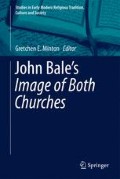Abstract
Still doth this chapter following (which is the last of this revelation) prosecute the spiritual and heavenly commodities of this city, concluding with most excellent admonitions and godly warnings.
Access this chapter
Tax calculation will be finalised at checkout
Purchases are for personal use only
Notes
- 1.
prosecute = deal with in detail, describe or set out in faull (OED v. 3).
- 2.
river] 1548; tyuer 1570.
- 3.
gracious] 1550(W), 1570; graciously 1548, 1550.
- 4.
communed] this edn; commoued 1548; commoned 1550, 1570, Christmas. See above, 384n.
- 5.
Jn 6.68.
- 6.
Ezek 36.25.
- 7.
have] 1570; hath 1548.
- 8.
the] 1570; they 1548.
- 9.
Lk 1.42.
- 10.
Ps 119.25.
- 11.
Ps 107.20.
- 12.
quodlibet = an academic exercise within a university in which a master or bachelor would discuss questions on any subject (OED n. 1a).
- 13.
communed] 1550, 1570; commoned 1548.
- 14.
whom = which.
- 15.
performeth] 1570; perfourmed 1548.
- 16.
not] 1550; nor 1548.
- 17.
of] 1570; in 1548.
- 18.
remembrance] 1570; remembraunces 1548.
- 19.
Boanerges = sons of thunder (the name given by Jesus to James and John; see Mk 3.17).
- 20.
of] 1550(W); om. 1548, 1550, 1570.
- 21.
were] 1548; where 1570.
- 22.
that = those things.
- 23.
Deut 5.7.
- 24.
antichrists] 1570; Antechryste 1548.
- 25.
one = i.e., one priest.
- 26.
breathed] 1570; breated 1548.
- 27.
of] 1570; om. 1548.
- 28.
thus] Christmas; this 1548, 1550, 1570.
- 29.
Bale attacks the Catholic belief that the priest must consume everything that remains from the Eucharist.
- 30.
This list of sententioners repeats some of the names Bale introduces on 119.
- 31.
Guido Terrena (see 119n.).
- 32.
Belphegor = a demon whose name derives from the Assyrian ‘Baal Peor’; he was associated with sloth and lechery.
- 33.
resort = to come, arrive (OED v. 1 10, citing this passage as the first usage of this rare and obsolete meaning).
- 34.
singing] 1548; ringyng 1550; ringin 1570.
- 35.
‘Absolve’ is the modernization of the 16th-century spelling ‘assoil’, meaning ‘to absolve from sin, grant absolution to, pardon, forgive’ (OED v. 1).
- 36.
mangy] 1548, 1550, 1570; many Christmas. OED lists Bale’s Three Laws (l. 1648) as the first instance of this word in the sense of ‘beggarly, mean, “lousy”, contemptible’ (adj. 3). In that case, the phrase is ‘mangy muttering’.
- 37.
leasing = lying, falsehood (OED n.).
- 38.
would] this edn; worlde 1548, 1550, 1570(?). The 1570 text is unclear at this point.
- 39.
saint] 1570; sait 1548; salt 1550.
- 40.
OED (gadder2) lists Bale’s Apology as the first usage of this word.
- 41.
These four cities were popular medieval pilgrimage destinations.
- 42.
3] 1550, 1570; placed after ‘I’ 1548.
- 43.
that = so that.
- 44.
forth] 1570; for the 1548.
- 45.
minish = diminish.
- 46.
come] 1570; om. 1548.
- 47.
take] 1570; taken 1548.
- 48.
give] 1570; gaue 1548.
- 49.
Bale is adamant in his defense of exegesis itself, using the precedent of Revelation and the church fathers in order to defend a work such as the Image.
- 50.
for] 1548; from 1570.
- 51.
5] 1570; 3 1548.
- 52.
nor] 1570; not 1548.
- 53.
household] 1548; shousholde 1570.
- 54.
2 Tim 2.5.
- 55.
tenth of John = Jn 10 (verse 30). Bale’s logic is that Arius, in denying the divinity of Christ, was excising the passage from the book of John which proclaimed the oneness of the Son and the Father.
- 56.
Photinus, like Arius, denied the oneness of Christ and God. Bale’s argument is that Photinus was adding to the gospel by emphasizing Jesus’ human birth from Mary.
- 57.
And both] 1570; And but 1548; And 1550, 1550(W).
- 58.
his] 1570; this 1548.
- 59.
adjure = the action of commanding or appealing to someone in the name of God (OED n. 2).
- 60.
The reference is to Irenaeus’ Ogdoad, written against Valentinus (see Eusebius 5.20).
- 61.
Bale is drawing on the tradition about the Oraculum Cyrilli, which purports to be a prophetic communication from a figure named Cyril of Mt. Carmel (also known as Cyril of Constantinople) to Joachim. This work originated in the 12th century in a Franciscan community, but the tradition of identifying Cyril as a Carmelite was later established, and reinforced by John of Hildesheim in the 14th century. See Andrew Jotischky, The Carmelites and antiquity: Mendicants and their pasts in the Middle Ages (2002).
- 62.
Simeon the Just was the Jewish high priest during the second temple period, and is mentioned in 2 Macc, Sir, and Josephus.
- 63.
goats] 1570; goat 1548.
- 64.
believeth] 1570; beleued 1548.
Author information
Authors and Affiliations
Editor information
Editors and Affiliations
Rights and permissions
Copyright information
© 2013 Springer Science+Business Media Dordrecht
About this chapter
Cite this chapter
Minton, G.E. (2013). The Twenty-Second Chapter. In: Minton, G. (eds) John Bale’s 'The Image of Both Churches'. Studies in Early Modern Religious Tradition, Culture and Society, vol 6. Springer, Dordrecht. https://doi.org/10.1007/978-94-007-7296-0_26
Download citation
DOI: https://doi.org/10.1007/978-94-007-7296-0_26
Published:
Publisher Name: Springer, Dordrecht
Print ISBN: 978-94-007-7295-3
Online ISBN: 978-94-007-7296-0
eBook Packages: Humanities, Social Sciences and LawPhilosophy and Religion (R0)

